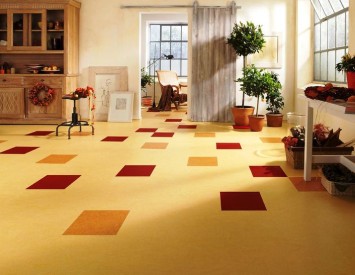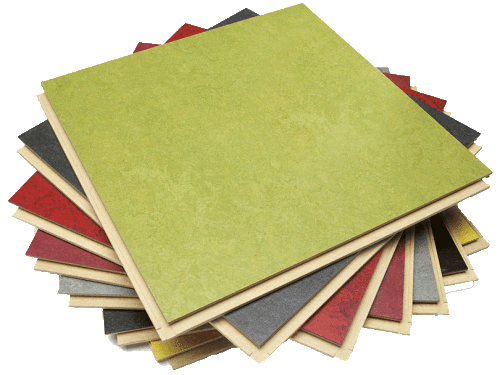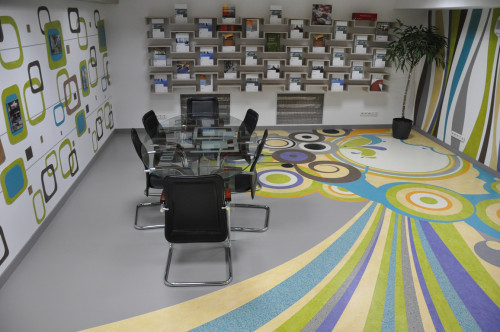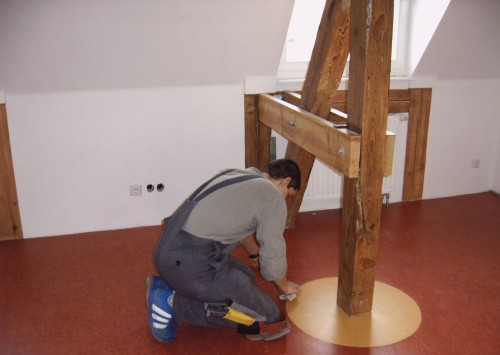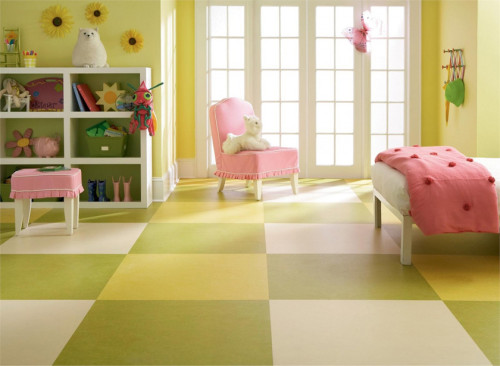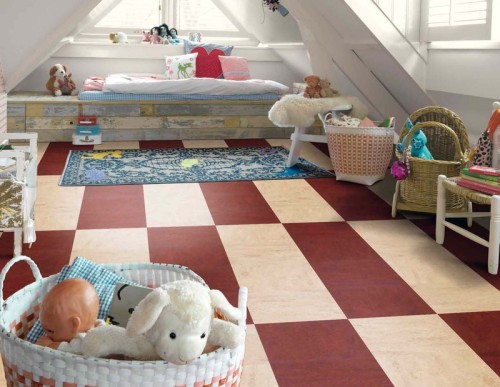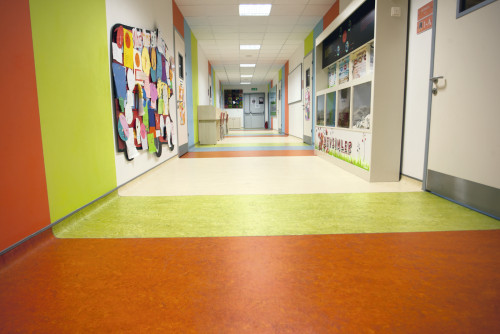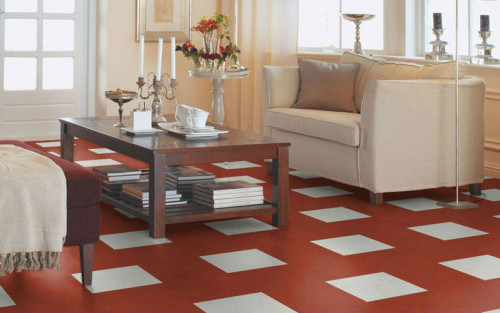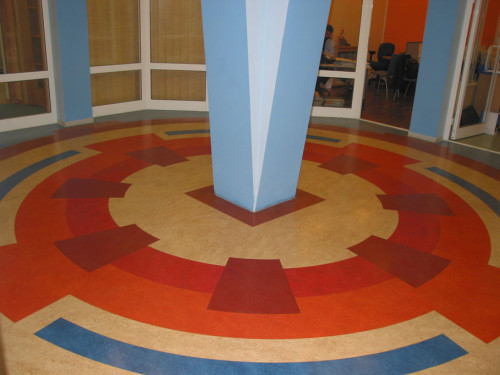Linoleum is one of the most popular materials for floor decoration. His closest relative, Marmoleum, has similar manufacturing technology and similar characteristics, but is noticeably different in component composition. In this article you will find detailed information about such a coating as Marmoleum, learn about its advantages and disadvantages, as well as installation methods.
Content
What is Marmoleum
Some manufacturers position Marmoleum as an innovative material, meanwhile, this is not entirely true. Marmoleum really appeared on the construction market not so long ago, but, in fact, it is a coating made using old technology using the latest equipment, as well as completely environmentally friendly raw materials. In appearance, production method and many technical and operational characteristics, Marmoleum resembles linoleum, only in its component composition there are no synthetic components. A similar material is considered to be something between linoleum and laminate, since Marmoleum combines the best properties of these two flooring.
As was indicated earlier, in the manufacture of such material, only natural raw materials are used. The following components are present in Marmoleum:
- resin of coniferous trees;
- wood flour;
- chalk;
- cork wood;
- linseed oil;
- coloring substances of natural origin.
The natural pigments used in the production of Marmoleum have a very wide color palette. Thanks to this, material manufacturers can offer potential customers a very wide range of their goods. A variety of color scheme of material allows you to enter such a flooring in various interior styles. By the way, the production technology provides for staining Marmoleum to its entire thickness, because even after years, when the material is somewhat isolated, it will not lose its original shade.
You can’t name the price of Marmoleum, but its high quality and excellent operational properties justify the cost. In addition, the high cost of coating can be due to the features of the process of its manufacture, which, I must say, takes a lot of time. The production of marmoleum can be briefly described in the form of such stages:
- At first, all the necessary components are mixed with each other, and then leave the resulting mass for ripening. This process lasts about 7 days, while the mixture should be withstanding at a certain constant temperature.
- When a week passes, the mass for the production of marmoleum is stained in the desired color by making the necessary pigments. After that, the substance is pressed on special equipment.
- The resulting layer is divided into stripes of a certain width and applied to the jute base.
- Then the future Marmoleum is placed in a drying chamber, where it ripens for another 14 days.
- Almost ready -made marmoleum is covered with a protective polymer layer. This layer will impede the rapid abrasion of the material and increase its durability. If desired, you can buy an absolutely natural marmoleum on which there is no polymer film, but you will have to care for such a coating regularly and carefully, rubbing its special compounds from time to time.
The first company to produce Marmoleum on the construction market is the American company Forbo. Despite the fact that now on sale you can find a product of various manufacturers, the Forob is still considered a high-class flooring that can last a dozen years. Such material meets all international quality standards, is considered environmentally friendly and durable.
The popular line of products of FORBO is Marmoleum Real. It is presented on the market in the form of panels or plates created from cork crumb and moisture -resistant NDF. The upper protective layer of the material has high wear resistance, as well as moisture -repellent properties. Such a coating is not damaged even from claws of animals and thin female heels.
The pros and cons of Marmoleum
Marmoleum has many positive characteristics that I would like to consider in more detail:
- As mentioned above, all components that make up Marmoleum are exclusively of natural origin. That is why the material is considered environmentally friendly, harmless to human health and the environment.
- Marmoleum refers to hypoallergenic coatings, in addition, it also has bactericidal properties. Such a coating can be used in a children's room without fear for the health of the baby.
- Despite the fact that Marmoleum is more expensive than an ordinary linoleum, it will still cost its owners cheaper than a laminate.
- This material has excellent soundproofing properties, in addition, it additionally insulates the floor. In the room where Marmoleum is laid, it will be quiet and comfortable.
- Such a coating does not fade from a long action of ultraviolet radiation, resistant to water, moisture and abrasion. Marmoleum is able to serve for many years without losing its color and beautiful appearance.
- Removing such a floor is quite simple, the dirt is practically not absorbed into it, and even if you are filled with the floor with oil paint, it will be enough to wipe it with a rag.
- Marmoleum is not electrified, besides, it is absolutely fireproof.
- There are a lot of colors of marmoleum, so almost every consumer can choose a product to his taste. At this time, manufacturers of Marmoleum produce products in 100 different basic colors, and the number of shades reaches at least 2000 options.
- This material can be used in any room, including in the kitchen. Marmoleum tolerates temperature changes and humidity well. When cleaning it, you can use a variety of cleaning products, because it does not enter into chemical reactions with them.
If you decide to buy a marmoleum, you should get acquainted with the shortcomings of this material:
- Such a coating is somewhat fragile than the features of its storage and installation are determined. You can twist the marmoleum into a roll no more than 1 time, while you need to turn it in such a way that the base of the leaf is outside. When laying, fragments of marmoleum can break along the edges, so the process should be carried out as careful as possible.
- Over time, Marmoleum can harden, which leads to the risk of the formation of cracks on the flooring.
- The material has a fairly large weight, as well as good plasticity. These qualities can be considered advantages if the coating is used for flooring. But for the facing of the walls, Marmoleum is not suitable, since it will be deformed over time under the influence of gravity.
- Another minus is that it is very difficult to get an even edge in the process of cutting a marmoleum. But they also learned to cope with this drawback, cutting the sheets only near the walls and masking the edges with skirting boards.
Classes of material and output forms
Marmoleum is presented on sale in several forms, so that the buyer can choose the most convenient option for himself:
- Marmoleum in rolls is easy to install and allows you to cover the floor with a coating in a short time. The standard roll of material has a width of 2 m, and its thickness is different and depends on the class of marmoleum.
- Marmoleum in the form of tiles is sold in several sizes: 50x50 cm and 30x30 cm. In contrast to rolled material, from the tiles you can put on the floor a pattern, which allows you to give the floor a unique look.
- The panels of Marmoleum have a size of 90x30 cm. They are easy to install thanks to a special castle system. In addition, such locks provide for the installation of the material with glue.
If we consider the marmoleum in terms of wear resistance and quality, 3 main classes of the material can be distinguished:
- Grade 21-23 is a general-purpose coating. Such a marmoleum has a relatively thin upper layer, the thickness of which does not exceed 2 mm. However, it is this class that is most often used in the decoration of residential buildings and apartments. Firstly, a similar Marmoleum costs somewhat cheaper than materials of a higher class, and secondly, the wear resistance of the coating is good enough to use it in housing rooms.
- Marmoleum of grades 31-33 is most often used in industrial premises where there is no large flow of people, but where there are constant static loads on the floor. The thickness of the upper layer in such a material is 2.5 mm, such a coating can easily withstand a large weight, but it is not too stable to alternating loads.
- Material of grades 41-43 is considered the most durable and wear-resistant. Its upper layer has a thickness of more than 3 mm. Such a marmoleum can withstand variable loads, for example, a large stream of people. Thanks to such qualities, the marmoleum of this class is used in public premises, where it is often crowded.
You should choose the appropriate type of material, first of all, based on the considerations of its purpose, and not based on the price and wear resistance. For example, the most expensive Marmoleum of the 41-43 classes will last many years if you finish them the floor of the shopping center. But if you lay it in a production room, it is deformed faster from static loads than a cheaper gramoleum of class 31-33. For a residential building or apartment, the coating of class 21-23 is quite suitable, the strength of which will be enough for the long service of the floor, and it does not make sense to buy the most expensive Marmoleum in this case.
Paul flooring by marmoleum
The longest service life of Marmoleum will possess if it is operated in favorable conditions. Such conditions mean that the ambient temperature should be at least +18 ° C, and air humidity should not exceed 60%. It is not recommended to lay Marmoleum in summer kitchens, on balconies, open verandas, loggias, in arbors, etc. It is best to use such flooring in bedrooms, halls, halls, living rooms, children's rooms, offices. We will talk about the features of laying marmoleum further.
Preparation of the work surface
Before purchasing the flooring, do not forget to properly inspect the material for defects. After Marmoleum is bought, it needs to be left for several days in the room where it will be used. Store the coating on a flat surface.
Before laying the marmoleum, the walls of the room should be plastered, and all windows and doors are installed. It is desirable that the working surface is as strong as possible and even even as possible. In the case when the floor is too crooked, it must be leveled by performing a dry screed or using a bulk floor. In addition, before laying Marmoleum, the base should be dry, with a humidity level of not more than 2%. The floor can be waterproofed using a plastic film of 0.2 mm thick. Separate parts of the film should be laid by about 20 cm, and the edges of the material should be started on the wall by at least 5 cm. In order to create additional heat and sound insulation on the floor, it is advisable to cover it with foamed polyethylene thickness of approximately 2 mm and a density of 30 kg/m³.
The process of laying marmoleum
The installation technology of rolled marmoleum is very similar to the technology of working with ordinary linoleum. In the process of laying, it is important to remember the fragility of the material and not bend it too much in order to avoid the formation of cracks.
To cover the floor with marmoleum, first you need to stock up on such tools and materials:
- pencil for marking;
- hammer;
- roulette;
- hacksaw or electric jigsaw;
- wooden bars;
- clinia with a thickness of about 1-1.5 cm.
If you use a marmoleum in the slabs, then you should in advance the location of the picture. It is advisable to immediately portray schematically how the elements of the material on the surface will be located. In such a figure, thresholds, various protrusions of the walls, niches, the location of the pipes, etc. should be designated.
The installation process of marmoleum can be described in stages:
- First you need to decide on the amount of the necessary material. Calculate how many whole tiles or panels can be placed on the width of the room. Then calculate the number of rows along the length of the room. Do not forget that along the perimeter of the floor you will need to make a small gap of 15-30 mm. This gap is subsequently covered with skirting boards and will become invisible, but in the case of temperature changes or plastic deformations, Marmoleum will have a reserve for expansion. In the absence of such a reserve, the flooring may swell. You can set the necessary gap using pre -prepared wedges.
- The first panel of Marmoleum must be laid in a comb against the wall. All other elements are interconnected by the ends until the row ends. It is convenient to adjust the panels with a hammer. In order not to damage the material, first you need to attach a wooden block to it, and then tap on the bar with a hammer, adjusting the position of the part.
- The beginning of the second row is made of trimming the panel or tile of the previous row. This fragment is inserted with a spike into the groove of the part of the first row, while the lock is not closed to the end, but a fragment is installed under the slope. To observe the slope, again use wood bars. In this way, all parts are interconnected by the ends until the row is completed. As soon as the panels of the performed row are laid, wooden bars remove and snap elements of the first and second rows.
- Similarly, finish the rest of the floor.
- If in the process of work the gap between the wall and the finishing material became less than 1 cm, the position of Marmoleum should be adjusted.
- If when laying the last row of the marmoleum plate is not placed in it entirely, the excess can be cut off with a jigsaw.
- In those places where pipes are laid on the floor, small gaps also need to be left between them and the coating. When the floor is ready, these places can be disguised as special overlays.
- When installing skirting boards, they are fixed only on the surface of the wall, but not on marmoleum. Such a coating should have some mobility.
- In the event that the details of the Marmoleum during the installation process were slightly damaged, defective places can be found using a compound of a suitable shade.
Marmoleum, photo:
